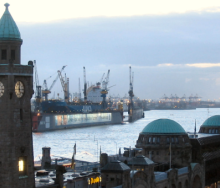E-micromobility, the use of e-bikes to deliver goods for the last mile of e-commerce and for private transport, is the way the world is moving towards green-energy-driven transport.
Victor Radebe, co-founder of the Mobility Centre for Africa, a non-profit organisation based in South Africa, highlighted the impact of e-bikes on the carbon footprint and how the mode of transport was about to transform the supply chain globally.
“There needs to be a war on private cars because they are our problem. The message should be, not cutting down on emissions, but quitting emissions,” Radebe told delegates at the Transport Evolution Africa Forum & Expo.
Micromobility is defined as the use of micro vehicles, which weigh less than 500kg, compared with an average car which weighs about 1,2 tonnes. According to a study by the EU Transport Authority, car trips are very inefficient, and some 60% of these can be replaced by micro vehicles.
“If you look at the Google footprint of the movement of your car you will see a lot of activity around your house and one or two trips a bit further because we all live 2km to 3km from where we get our necessities,” Radebe said.
He added that in China, the EU and the US, most trips were less than 5km from home.
“In the EU and North America there is a big revolution of e-bikes. If you ride it to work you are going to cycle but on the uphills you get power. An e-bike uses five to 15 watt hours for every kilometre. A car uses 20 times more,” he said.
“The biggest problem with cars is that a car has an average occupancy of 1.5%, not to mention that the boot space might be underutilised and the car stays parked for 95% of the time.
“We need to migrate to micromobility. More than half of all urban spaces are dedicated to cars. City planners first look at how wide the roads are going to be, and that for every square metre of building there needs to be ‘x’ number of parking spaces. What are we ending up with? Empty parking spaces, which are just dead space. Car-centric land use planning is choking our cities.”
Radebe said, while working with planners at the KwaZulu Natal provincial government on the development of the Durban aerotropolis, he had noticed a tendency to plan for vehicles and not bikes.
“A modal shift from cars to micromobility would free up to 37% of urban spaces but there are still too many barriers to electric vehicle adoption. The problem is that it militates against a just transition.”
He said drawing power from the grid to power e-vehicles was not the solution, and manufacturers should move directly to carbon-zero solar-powered vehicles. However, original equipment manufacturers (OEM) were not considering solar and had no current plans to introduce affordable electric vehicles into the market. For example, the Jaguar I Pace costs around R2 million compared with an ICE equivalent, priced between R1.4m and R1.5m.
“The OEMs want to sell us high-end models and they want the government to subsidise it – the Jaguar I Pace, BMW i3, Porsche Taycan and Volvo CX40. These are the electric vehicle models coming into South Africa…there is nothing low end,” Radebe said.
“There is no one talking about electrifying the Toyota Quantum or the VW Polo. The reason they go high end is because these models are profitable.”
“Toyota, Nissan and Mercedes are not planning to decarbonise the minibus taxi fleet that moves over 70% of daily commuters, neither is this in the government’s plans to do so,” he said.
There are 1.5 billion cars in the world that travel 24 trillion kilometres a year, 90% of which are internal combustion engine powered vehicles. These vehicles account for 6Gt of CO2 emissions and research shows that electrifying all vehicles will result in a 75% reduction in emissions.
“Maybe we should not be talking about cutting down but about quitting and saying some of the shorter trips can be replaced by micromobility such as the last mile trips of e-commerce,” he said.
He said it would be easy for SA to localise micromobility electric vehicles and battery manufacturing.
“The easiest thing for us to build and localise in SA is a bike. We can manufacture the frame and the mirrors locally but will probably have to import the motor.”
He said a business associate was already in the process of bringing 500 e-bikes into SA for use in the urban space by firms such as Uber Eats and Mr Delivery.
“All shopping malls have solar panels so we are going to try and go directly to solar,” Radebe said.













